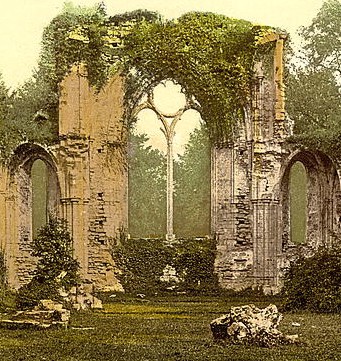
(go to Abbey Pages Home)
(go to Monastic Pages Home)
Leave a Comment
 |
to Historyfish Home) (go to Abbey Pages Home) (go to Monastic Pages Home) Leave a Comment |
 |
|
.
 A word about
Abbeys A word about
AbbeysTo Abbey Pages Home.
Abbeys sprung up as the monastic movement matured. Early monastics lived at home, or in the Egyptian desert, or in small communities. As the movement grew, monasteries not only flourished, but often became very wealthy. Abbeys owned enormous tracks of land and were centers of food supply, craft commerce, and home to the greatest intellectual thinkers of their day. Abbeys were often owned, but always governed, but the richest, most influential families. Many Abbeys were founded by royal personages who were later sainted. Abbeys were hugely powerful, which was in part what lead to the downfall of many. The rest were done in by changing religious times, and the upgrowth of protestantism. It's hard for us to conceive now of how vital a part Abbeys played in the lives of the people of the medieval ages. Abbeys were the nexus of cultural life, and served as hospitals, asylums, soup kitchens, and schools. The monastics improved agricultural tools, techniques, drainage and land use. They cultivated plant varieties and perfected wine and cheesemaking. They cared for orphans, and supervised justice, provided employment and sustained the economy for villages for miles around them. Abbeys were the site of lengthy pilgrimages, where the faithful came to pray. The poor would be served a meal and have a place to sleep. The rich, too, though in far better quarters. Monastics were educated, professional men and women, scribes, poets and visionaries whose mandate was to provide care to the needy and serve the faithful. Monastic faith played out in the work of and support of the greatests artists of the age, who created magnificent manuscripts, architecture, tapestry, embroidery, murals and other paintings and the composition of music and performance of song. Oratorios written to be performed in cathedrals brought the sounds of the angels into the world. In England,
during the
reformation and after the dissolution of the
monasteries, the Abbeys were plundered. Silver and gold
chalices were sold or stolen, relics burned, ruined or scattered,
mosaics pried up, wrought iron melted down, and even the very bricks
carried off to be reused in another building somewhere else. Few of the
favored lords who received Abbey property bothered to preserve or
protect it. What rioting, burning, plundering and neglect left
standing, time eroded. It was a similar pattern elsewhere. Yet
even
in ruins, the great Abbeys are a testament to medieval people's faith,
and the power of that faith.
Learn more about life in an abbey on my monastic pages. View more pictures, go to the Photochrom Pages on Historyfish. |
|
|